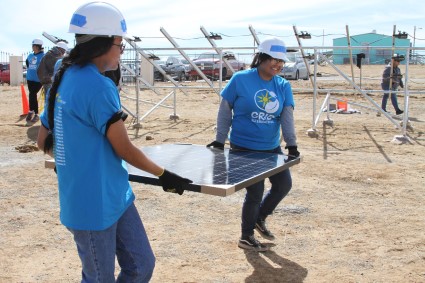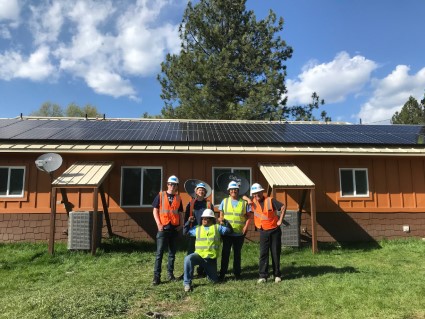Tim Willink, GRID’s Director of Tribal Programs, gives us an update on what’s going on in Indigenous communities during the pandemic, and the exciting projects in store for the Tribal Program.
How are Indigenous Communities dealing with the pandemic right now?
In my view, a number of Indigenous Nations have been hit really hard by COVID-19 yet most seem to be very proactive in how to approach the virus, incorporating measures such as road blocks, curfews, mandatory face masks in public, public service announcements on social distancing and washing hands, frequent testing, contact tracing and quarantining - as much as possible given limited resources.
A few Tribal communities, such as the Navajo Nation, are being hit particularly hard by the COVID-19 crisis right now. Why is this, and what can people do to help?
The history of colonization has resulted in so many factors contributing to this crisis including, but not limited to chronic underfunding and lack of infrastructure of Indian Health Services. A lot of our people also have health issues, caused in large part by these factors including the lack of infrastructure. For instance, I believe there are only 13 grocery stores for the whole Navajo Nation, which is the size of West Virginia, meaning to get supplies you have to travel a far way. A portion of the Navajo Nation don’t have running water, much less access to hand sanitizers or masks. There is a housing shortage, so many multi-generational families may live in one place, making it difficult to physically distance at times nor quarantine when a member of the family gets sick.
 This is a story of being hit hard, of having one of the largest infection rates of the country, which is tragic, but to me it’s also a story of resilience. The Navajo Nation health care workers and administration have done an admirable job under a lot of duress. President Nez has regular informational sessions on Facebook which are filled with a ton of data on hotspots, who’s most affected and the cases in border towns and neighboring states. I was really impressed with his role modelling of wearing a mask and his expertise on being proactive in combating this terrible virus. Also people at the community level are pitching in, working very hard to bring in much needed supplies, and Tribal partners are setting up Go Fund me pages. We’ve gone from experiencing one of the most infectious rates in the country to indications the curve is flattening, but there is still much work to do. If you want to help, support initiatives that fund the under-resourced infrastructure in Tribal communities.
This is a story of being hit hard, of having one of the largest infection rates of the country, which is tragic, but to me it’s also a story of resilience. The Navajo Nation health care workers and administration have done an admirable job under a lot of duress. President Nez has regular informational sessions on Facebook which are filled with a ton of data on hotspots, who’s most affected and the cases in border towns and neighboring states. I was really impressed with his role modelling of wearing a mask and his expertise on being proactive in combating this terrible virus. Also people at the community level are pitching in, working very hard to bring in much needed supplies, and Tribal partners are setting up Go Fund me pages. We’ve gone from experiencing one of the most infectious rates in the country to indications the curve is flattening, but there is still much work to do. If you want to help, support initiatives that fund the under-resourced infrastructure in Tribal communities.
Why is energy sovereignty important?
A lot of Indigenous Nations have experienced first hand the negative effects of extractive industries. The Navajo Nation has a history of uranium, coal, and oil and gas mining, and while these industries have provided jobs and financial benefits, they have also caused harm to the land, water, and air. A lot of Tribes, including the Navajo Nation, want to take more control of their resources, striving towards energy sovereignty. A number of Indigenous Nations are looking to do this by incorporating more solar energy into their energy portfolios. By gaining more control over our resources, Indigenous Nations can benefit from smart energy development while minimizing harm to our environment.
Solar energy is a form of economic stimulus for local communities. Our clients are low-to-moderate income, so it could be an annual savings of a few hundred a year, but that can make a significant difference and lessens their energy burden. Indigenous Nations can incorporate workforce development, and train our own people to develop, install, and maintain their own solar systems. With solar, the cost savings stay on the reservation and the local economy.
 Even though your installation work is on hold right now because of COVID-19, you've got a ton of exciting projects in the works! Tell us about the grants the Tribal program and your partners just received.
Even though your installation work is on hold right now because of COVID-19, you've got a ton of exciting projects in the works! Tell us about the grants the Tribal program and your partners just received.
The Department of Energy just awarded five Tribal Nations we partner with grants to install solar energy, totalling over one megawatt of solar energy! With the grants, five Tribes will be installing solar, including the Spokane Tribe, the Ute Mountain Ute Tribe in Utah, Blackfeet Community College, the Oglala Sioux Tribe, and the Bishop Paiute Tribe. The solar energy will bring significant cost savings to Tribal members and families, providing Tribal members with hands-on solar installation experience for community members including, Blackfeet Community College students and allowing Tribal administrations to provide more for its citizens through energy savings. We’re incredibly excited about these projects!
If you want to continue supporting our work, become a GRID member of our Tribal Program!
Special shout out to Patagonia, The Honnold Foundation, US Bank, All Points North Foundation for their support of our Tribal Program work. Thank you also to equipment partners: Simpliphi Power, SnapNrack, Enphase, and Jinko.
